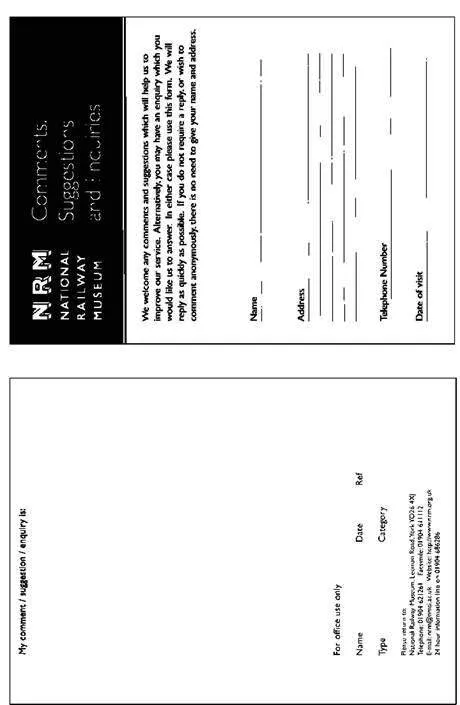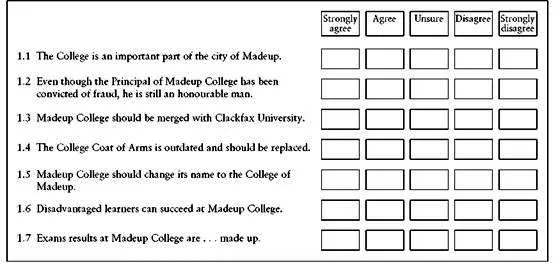Chapter 1
Questionnaires
In this chapter we
- introduce questionnaires as a research tool
- explore the uses of questionnaires
- examine the different types of questions used in questionnaires
- look at design issues specific to questionnaires
- provide hints on how to maximise response rates
- indicate when to use, and when not to use, questionnaires
- discuss piloting your questionnaire
- briefly consider web-based questionnaires
- examine approaches to analysing data
- identify the limitations of questionnaires
How do we obtain information from individuals regarding their views on particular topics or issues? What is an effective and efficient way of eliciting those views and opinions? We could ask questions of them one by one and record their responses in some way. However, if many people are involved this soon becomes and inefficient and ineffective way of collecting data. In addition, the structure of respondents’ answers may not conform to our desired method or an approach to analysis. The questionnaire is the favoured tool of many of those engaged in research, and it can often provide a cheap and effective way of collecting data in a structured and manageable form.
While questionnaires can be very detailed, covering many subjects or issues, they can also be very simple and focus on one important area. A simple yet effective questionnaire is that used by the National Railway Museum in York (Figure 1.2). This form is placed at key locations throughout the museum and its purpose is to seek comments from visitors. This instrument allows the museum to collect, in an effective and efficient way, visitors’ views on museum facilities–information of potential value to the future operation of the venue.
Suppose you work in a record store and you’d like to find out which kinds of music some of your younger customers listen to. You think it’s a good idea to jot down some questions on some brightly coloured paper (because you’ve heard that’s what youngsters like), and you feel like a proper researcher when you hand out your question sheets in the shopping precinct on a wet Saturday afternoon. However, you are horrified when you receive the responses. Most of those returned (three out of the 400 distributed) are not completed–indeed, over half (two of the three returned) are blank. What have you done wrong? You’ve discovered that designing an effective questionnaire is no easy task!
Questionnaires can be difficult to design and analyse. Questions posed can be misleading or ambiguous; they may need to be targeted at specific, difficult to reach, groups; and they can create hours, days or weeks of work in analysis. However, a well-planned and well-executed questionnaire campaign can produce rich data in a format ready for analysis and simple interpretation. If correctly managed they can be less resource-intensive than many other research instruments, and they can help gather views and opinions from many individuals, or ‘respondents’ as they are more commonly termed. Questionnaires have been centrally used to provide an indication of the make-up of society in the UK for centuries in the form of periodic census surveys and are often used by large organisations to establish people’s views and opinions on a wide variety of topics.
Why use a questionnaire? Why might they be useful?
We often require information on a range of subjects and to obtain that information we may be required to ask people questions. Questionnaires can be designed and used to collect vast quantities of data from a variety of respondents. They have a number of benefits over other forms of data collection: they are usually inexpensive to administer; very little training is needed to develop them; and they can be easily and quickly analysed once completed.
An effective questionnaire is one that enables the transmission of useful and accurate information or data from the respondent to the researcher. This is a complex process which involves presenting questions in a clear and unambiguous way so that the respondent may interpret them, articulate his or her response and transmit it effectively to the researcher. Once transmitted, the answers must be recorded, coded and analysed fairly so that they accurately reflect the respondents’ views.
FIGURE 1.2 National Railway Museum question form
Types of questionnaire
Essentially, there are three broad types of questionnaire–the mail survey, the group-administered questionnaire, and the household drop-off survey. The mail survey is, by far, the most common questionnaire type. This instrument is addressed to respondents and delivered by mail, and can be an efficient way of collecting large amounts of data. The mail survey is, however, sometimes considered impersonal and can suffer from low response rates.
The group-administered questionnaire is a useful instrument for collecting data from a sample of respondents who can naturally be brought together for the purpose. For example, we have often used group-administered questionnaires in our own research to collect data from students attending a lecture, teachers in a school and medical personnel in hospitals. This type of instrument allows each member of the group to complete his or her own questionnaire and return it to the researcher on completion. Response rates using group-administered questionnaires can be higher than those for mail surveys, as the group is often assembled specifically for the purpose of assisting with the research and the respondents feel personally involved with the work by being handed the questionnaire by a member of the research team.
The household drop-off survey is a hybrid of the mail and the group-administered survey. Using this approach, the researcher delivers the questionnaire by hand to a member of an identified household for collection at some later date. Among the advantages of this approach are that the drop-off and subsequent collection affords the opportunity for those completing the instrument to clarify questions posed with the researcher.
Types of question
When conducting research we are often interested in collecting data covering a broad range of subjects. Using subtly different questions, and approaches to questioning, can allow us access to the information we require. Questionnaires usually are comprised of a number of different approaches to asking questions–the essential ones being: closed questions, multiple-choice or ranking questions, and open-ended questions (Box 1.1).
BOX 1.1 Question types
Closed questions
Most questionnaires consist of a collection of closed questions. These are questions to which all possible answers are provided. The most often-used form of closed question is the dichotomous question requiring a ‘yes’ or ‘no’ response. For example, ‘Do you wear glasses?’ is a dichotomous question: the respondent either does (responding ‘yes’) or doesn’t (responding ‘no’) wear glasses.
Multiple-choice questions
Many questionnaires include questions which provide a number of predefined responses. This allows the researcher to hold some control over the responses given. However, the construction and piloting of multiple-choice questions usually require careful thought to ensure that all or most responses possible are covered. A typical multiple-choice question would be: Which of the following are important attributes of an employee? (Please tick all that apply)
- Good timekeeping
- Well developed customer relation skills
- Good numerical skills
- Ability to liaise with other staff in other departments.
Open-ended questions
Open-ended questions impose none of the restrictions of closed and multiple choice questions. They allow for the recording of any response to a question provided by the respondent. The answers to open-ended questions are in no way predetermined–this can make analysis difficult. Each response must be recorded and analysed or coded to reveal the meaning of the response. A typical open-ended question would be: ‘Tell us about the area you live in?’
Scale items
Some questions require the respondent to indicate answers according to a predefined list or scale, usually ranging from a very positive answer to a very negative answer. There are a number of ways to scale responses to questions. One of the most popular approaches is the Likert scale (published in 1932). This scale, like many others, measures attitudes to set statements put by the questionnaire. The respondent is provided with a scale of possible responses (usually five) to the question–ranging from the attitude measure ‘strongly agree’ to the exact opposite measure of ‘strongly disagree’.
In their work, exploring the public perception of Madeup College, researchers used Likert-type questions in one of their instruments distributed to the residents of Madeup (Box 1.2). This questionnaire asks respondents to tick one area on the rating scale. The questions used in this instrument had been gathered through focus-group work with a select sample of local residents.
BOX 1.2 Likert-type questions
Other approaches to scaling responses exist and are often used to evaluate products or services. Hertfordshire Insurance Consultants mails postcard-sized questionnaires to its customers seeking views on the services they have received from their insurance consultant (Figure 1.3). The majority of the questions posed are of ...


